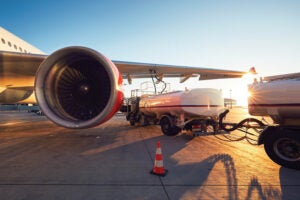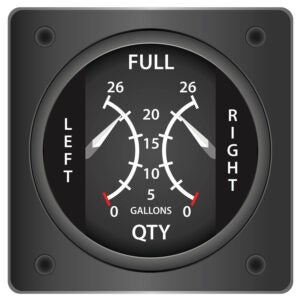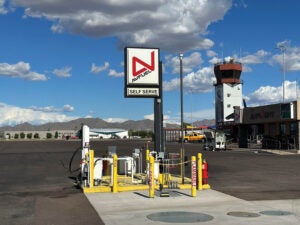
Having more gas on board than needed for a given flight seems easy enough to comprehend, yet every year an alarming number of flights end abruptly and often tragically when the tanks run dry before the flight is safely at its destination. It’s maddening that one of the easiest factors to control remains one of the most destructive—and lethal.
While fuel exhaustion accidents are far more common in the general aviation world, even airliners with multiple layers of procedures and verification aren’t immune, as the tragic example of Avianca Flight 052 near New York can attest. (In 1990, a Boeing 707 crashed near JFK after exhausting its fuel in a holding pattern after a missed approach. Poor communication among the crew themselves and ATC were primary factors.) Thankfully, true fuel emergencies in the airline world are extremely rare. However, instances of diversion to an alternate airport because of fuel issues are actually more common than an industry outsider would suspect. Those diversions can happen for myriad reasons but occur when the flight’s dispatcher and/or captain determine that the original destination will not be reached or become available prior to reaching the “bingo fuel” point.
In a world of heavily standardized phraseology, the term bingo fuel is a bit of an anomaly. It isn’t officially recognized but is used commonly in military and airline operations. In a nutshell, bingo fuel is a calculated amount of fuel where upon reaching that fuel status prior to the designated point, Plan A must be abandoned in favor of Plan B. This change of plan is most commonly accomplished by diverting from the original destination to a suitable alternate.

Sweating Fuel
Over the course of about 30,000 hours of flying aircraft large and small, I have had three instances where I have “sweated fuel.” Each was in a different era of my flying experience and each taught me some very valuable lessons. Sweating fuel is a miserable feeling.
The first incident happened during my first real flying job flying river runners and canyon tours around the Grand Canyon and Lake Powell area. I’d flown a Cessna 207 into Bar Ten ranch (1Z1) on the north rim of the Grand Canyon. As I shut down, my boss came up to me and told me to take the Cessna 210 that he had just brought in and fly it down to Williams, Arizona (KCMR), to pick up two charter passengers and fly them to Deer Valley (KDVT) airport near Phoenix. After dropping them off, I was to fly the airplane to Las Vegas (KLAS) to meet up with everyone else. His parting words were a cryptic “I just had it fueled in Page, so you shouldn’t need fuel until Vegas.”
This was the mid-1980s so there was no GPS and no fuel totalizer in the airplane, just those infamous Wichita fuel gauges, a fuel flow indicator, the manual’s performance charts and a clock. With the first two legs complete, all I had to do was fly the last leg back to Vegas. It was about halfway back that whispers of doubt started entering my mind as the fuel quantity indications just weren’t adding up. Without any cockpit reference for groundspeed or winds aloft available, I got a groundspeed report from ATC, which to my shock and dismay was over 20 knots less than I had expected. I set about plotting options with a paper chart on my lap. The fuel quantity indicators just kept falling and would swing a needle’s width back and forth with every bump.
At that point in my career, I’d never heard of bingo fuel, but I certainly understood the underlying concepts. I determined that the original Boulder airport (now closed) would be my alternate and that a point where my course to Boulder would diverge with intercepting the tour-plane VFR arrival into KLAS would be my decision point.
I didn’t want to show a lack of trust in what my boss had said about sufficient fuel and, quite frankly, only had a few dollars and no credit card on me. I surely didn’t want to be stuck finagling payment but I really didn’t want to be on the evening news blocking a freeway or golf course in Vegas. That imagery, coupled with my fuel status at the decision point, compelled me to make my first-ever bingo fuel decision and divert. Once the decision was made and the descent to Boulder initiated, it was actually calming. Safely on the ground, I used every crumpled dollar I had on me to purchase $17 worth of avgas—about 14 gallons those days—to continue to Las Vegas without further incident.

Airliner Fuel
The next fuel squirm experience was during my airline career flying Boeing 737s. The one flight where I pushed back from the gate with the most contingency fuel on board, we arrived hours later at the destination with the least amount of fuel (measured in minutes) of my career. It was a nasty winter flight from Portland, Oregon (KPDX), to Oakland, California (KOAK), that due to numerous factors, a couple of which I’ll describe below, had doubled its originally scheduled block time. A major factor was that Oakland’s neighbor, San Francisco (KSFO), was enduring freakish winds that were forcing many of their flights to divert to Oakland and San Jose (KSJC), gumming up the whole Bay Area system. En route, dispatch twice amended our alternates to closer-in airports requiring less fuel in a (successful) attempt to increase our bingo fuel point(s). Of course, my first officer and I double-checked the math before accepting each amendment.
Toward the end of the flight, we were in our second holding pattern of the flight. We were low on a holding stack with a company flight going to our destination above us. ATC said that they could take one of us in now and the other one after one more turn in holding, and to sort out between the two of us who would go first. We declared our fuel state and our company flight declared a slightly lower state, so they were cleared out of the hold first and we were given the promise of an approach clearance after one more turn. Between the other flight’s landing and ours, ATC inserted an emergency wide-body from SFO that caused us additional delay vectors over the bay that we only accepted because our low altitude allowed Oakland and our final alternate San Jose to be in sight through the rain.
When we were finally at the gate shutting down for the night, we heard another pilot come down the jetway and stand at the open cockpit door and loudly express a version of “holy crap!” as he looked at our fuel gauges. He then said that he was the captain of the other flight and confessed to “fudging” their fuel status, justifying that act by assuming that we had done the same thing. He said he heard our final arrival delay over the radio and stuck around to see that we got in OK and to apologize for “jumping the line” in the hold. We all agreed that it had been a crazy night. I may have mumbled something discourteous under my breath as he left.
The flight was successful, procedurally correct and legal. But in the end, it was not worth the compounding pressure and exposure. It was the only flight in my career where I officially declared “minimum fuel” with ATC and in hindsight, if I had it to do over again, I would have simply diverted to an alternate much earlier in the flight.
Consternación en México
The last fuel stress experience was years later in my RV-10. A group of us who fly for the Flying Samaritans decided to take a group trip down to Mexico to visit Copper Canyon. We entered and cleared Mexican immigration and customs at Guaymas (MMGM) just like we routinely did for the Sams trips. There, we refueled for the round trip to El Fuerte (MM79) where no fuel would be available. Due to the weight of four adults with considerable baggage, I knew I couldn’t just top off in Guaymas, so I calculated what I would need for the round trip to El Fuerte, padded it as much as weight would allow and gave the order to the fueler while I went inside the office to start the requisite paperwork.
When I came back to the aircraft for the last leg, I realized that I didn’t quite have the total amount of fuel on board that I had expected. Apparently, between my original calculations, the conversion to liters, my order in rusty Spanish or a mistake by the fueler, my upload was about 10 gallons shy of what I was expecting. As the rest of the airplanes in the group were powering up to depart, I did another recalculation of the fuel needs for the flight. It showed that I had enough fuel on board to legally conduct the flight; however, I didn’t have the extra cushion with which I routinely prefer to operate.
The flight to El Fuerte was uneventful. By operating at less than my usual ego-driven high-speed cruise and furthering my transition to LOP operations, I actually burned a couple of gallons less than expected. Returning to Guaymas would be no problem as long as nothing irregular should happen.
The train trip through Copper Canyon was wonderful, but several times I found my mind wandering back to the annoyance of not having as much fuel as I would have liked and all kinds of “what ifs” that could be encountered on the trip back. I was upset at myself for not taking the additional delay to complete the upload. My biggest concern was that Guaymas only had one runway and, in the event of a sudden closure, had no appropriate alternates close by.
To ease my mind, I decided to formally calculate a bingo fuel point. Between El Fuerte and Guaymas was Obregon (MMCN), which was a full-service commercial airport. We would basically pass Obregon on a high/wide downwind to the runway and I calculated a hard and fast bingo fuel amount that my totalizer would have to show abeam Obregon in order to continue to Guaymas. I pledged to myself that anything less than that amount would compel me to divert to Obregon. No amount of hassle or embarrassment by the diversion would be worth sweating fuel at Guaymas in the face of a further unexpected event. Ultimately, we crossed the bingo fuel point above the calculated minimum amount and continued safely, legally and uneventfully to Guaymas with enough fuel to return to Obregon if forced to.
Fuel on board is one of the easiest things that we have in our control yet fuel exhaustion incidents continue to happen. More engines stop producing thrust early due to lack of fuel than any other reason. Fairly recently, a very experienced and respected member of a local EAA chapter was forced to dead stick from the traffic pattern due to fuel exhaustion. We all need to do better and we can. Here are a few ideas for all of us to take higher command of our state of fuel.
Before-flight planning. For any flight, long or short, always make careful consideration of what the conservative fuel requirements will be for the considered flight (Plan A), as well as alternate plans if fate forces a Plan B. Especially consider unique attributes of the destination, like remoteness or available runways. Always have charts and data available for alternate destinations. The electronic world makes data carriage much easier than the paper days; nevertheless, a WAC chart in the seat-back pocket can be a lifesaver.
Preflight. Always confirm that the fuel on board meets the preplanned minimum and is protected by secure caps and no leaks.
In flight. At some point or points during cruise flight, get in the habit of verifying that the current fuel quantity and fuel consumption rates are appropriate and make sense. Far better to catch an improper mixture setting, faulty gauge or significant leak early than late.
Bingo fuel. Get comfortable and experienced calculating where a predetermined fuel status at a predetermined point should compel the flight to abandon the original plan for an alternate. The flight doesn’t even have to be iffy in nature. Practicing when things are normal will make the process easier when the chips are down, which, unfortunately, is something that can happen to any pilot on any flight. Stuff happens. As an instructor, I had a student have to divert to an alternate airport on her second solo flight after a gear-up landing closed ours. Always be prepared and remember that legal doesn’t always mean sufficient.














Turboprop airline pilot here. One flight a couple years ago, weather caused us to miss the destination. Alternate was supposed to be 5sm visibility and 2000ft ceiling. We got there to find 1/2sm visibility, well below the minimums. Luckily we had taken some extra fuel. We used all the extra and some of the reserve by the time we landed at another nearby airport using the ILS to 400ft. That airport also having a surprise snow storm.